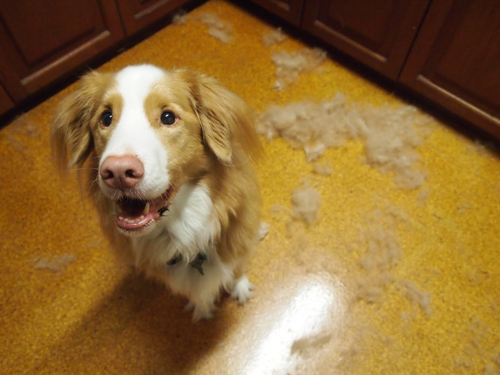Dr Sahil K Bhatti
Dogs naturally lose old or damaged hair by shedding. Although shedding is a normal process for dogs, the amount and frequency of hair that is shed often depends upon their health and breed type. It can also depend on the season. Many dogs develop thick coats in the winter that are then shed in the spring. Dogs that are always kept indoors, however, are prone to smaller fluctuations in coat thickness and tend to shed fairly evenly all year.
What Would Make a Dog Shed Excessively?
Excessive shedding in any breed can be caused by both nutritional and environmental factors. Shedding has another seasonal component. Dogs that spend a lot of time outdoors take their clues from the amount of sunlight they receive, shedding most in the spring as days grow longer. With less sunlight and cooler temperatures, dogs shed again as their thicker winter coat grows in.
Hormones also play a part. After females have whelped or gone through a heat cycle, they often drop coat. Spaying and neutering also change a dog’s coat, leading to more shedding and sometimes making them sprout fuzz.
Regarding diet, make sure the food you choose has nutritious and usable ingredients. The best premium and holistic foods feature a combination of fats, carbohydrates, vitamins, minerals and protein sources to keep your pet healthy. But some brands on the market still have ingredients that dogs cannot easily process such as corn, wheat, cellulose. Omega 3 and Omega 6 adding a daily supplement may help alleviate your dog’s shedding problems
Excessive hair loss or bald patches may be due to one of the following:
Parasites (fleas, lice or mites)
Fungal or bacterial infections
Inhalant or food-related allergies
Kidney, liver, thyroid or adrenal disease
(including Cushing’s)
Pregnancy or lactation
Certain medications
Self-induced trauma due to licking
Cancer
Immune disease
Sunburn
Contact with irritating or caustic substances
How to Minimize Dog’s Shedding?
*Brush your pet : Regular, even daily, brushing is the best thing you can do to keep your home free of hair. Brushing will also make your pet’s coat softer, cleaner, and less likely to shed.
*Feed an appropriate pet food : A pet’s coat is often a reflection of what they eat. Feed a high quality food with good digestible protein sources.
*Feed a fatty acid supplement like Omega 3 and Omega 6 supplements.
*Control allergies and fleas.
*Bath your dog : A clean dog will have a healthier coat. A gentle shampoo once a week or so will clean without drying the skin and rejuvenate a lackluster haircoat.
*Have regular checkups: Many diseases can affect the skin and haircoat. Regular visits to your veterinarian will help identify problems early, and provide more effective treatment.
*Use the right brush like Slicker Brushes .
*Remove hair from upholstery and your dog’s bed as soon as possible.
When is it Time to See the Vet?
If you notice any of the following conditions, or if your dog’s initial skin problem persists for more than a week, consult with your veterinarian for treatment.
Skin irritation, including redness, bumps, rashes or scabs
Open sores of any kind
Bald spots or thinning of coat
Dull, dry hair that pulls out easily
Scratching
Constant foot licking or face rubbing.
(The author is PhD. Veterinary Consultant)


